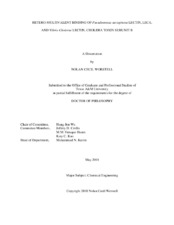| dc.description.abstract | Adhesion of carbohydrate binding proteins called lectins to cell membrane components mediates pathogen interactions with host cells. In working with cell membrane mimicking lipid bilayers, we observed that weak affinity receptors could be activated by high affinity receptors leading to significantly higher binding of the pentameric lectin cholera toxin subunit B, CTB. Weak receptor activation was probably mediated via the Reduction of Dimensionality (RD) mechanism. In RD, once a protein has attached to a strong receptor, subsequent binding events are confined to a two-dimensional cell membrane surface enabling weak affinity receptors to be secondary receptors due to the enhanced effective concentration. Based on our CTB experiments, we expected that the inherent RD mechanism could induce heteromultivalent binding in most multivalent systems.
To confirm RD as a fundamental mechanism, we studied a second multivalent binding lectin. This lectin, LecA, is a tetrameric lectin that mediates Pseudomonas aeruginosa adhesion to host cells and biofilm formation. Our data showed enhanced LecA binding to mixture bilayers composed of both Gb3 and moderate or weak affinity receptors. Furthermore, moderate affinity receptors enhanced weak affinity receptors. Interestingly, our data showed that multivalent binding affinity and binding capacity were not necessarily correlated with their monovalent counterparts. A colloidal aggregation assay of LecA interacting with Gb3 and LacCer demonstrated that LecA’s binding affinity was Gb3 > Gb3+LacCer > LacCer. The colloidal binding affinity agreed with prior data binding affinities confirming that multivalent binding affinity and binding capacity cannot be assumed from monovalent data. Therefore, our data suggest the RD mechanism is a fundamental multivalent binding mechanism. To efficiently discover hetero-multivalency in various multivalent systems, we developed a turbidity-based emulsion agglutination (TEA) assay amenable to high-throughput screening of lectin binding. This assay utilizes the coagulation of emulsions to determine heteromultivalent binding. The results of the TEA assay matched our prior LecA data and were corroborated by dynamic light scattering. In summary, we have demonstrated the RD mechanism, verified that the RD mechanism can play a role in multiple multivalent systems, and developed an assay to efficiently screen large molecular libraries for heteromultivalent binding resulting from the RD mechanism. | en |


